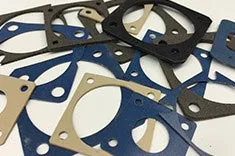EMI Shielding Products
- Custom Gasket Fabrication
- Connector Gaskets
- Bonded O Ring
- Custom Gaskets
- Conduct-O-Knit Knitted Wire Mesh
- Conduct-O-Seal Combo Gasket
- Conduct-O-Elastomer
- Conduct-O-Seal Oriented Wire in Silicone Gasket Material
- Conduct-O-Mesh Tape
- Conduct-O-Foam
- Conduct-O-Bond
- Optical Filters For Electronic Displays
- Shielded Vent Panels
- ESC Board Level Shielding
- 300 Series
Why is RFI Shielding Used in the Aerospace Industry?
 Have you ever felt uneasy when realizing a technical misstep might jeopardize an entire aircraft’s communication link? The fear stems from knowing how high the stakes are once you’re thousands of feet above the ground, dependent on clear transmissions to coordinate everything from pilot instructions to critical data flows. The risk of interference disrupting any of these signals can send the most composed team into scramble mode—a tension no one wants to face.
Have you ever felt uneasy when realizing a technical misstep might jeopardize an entire aircraft’s communication link? The fear stems from knowing how high the stakes are once you’re thousands of feet above the ground, dependent on clear transmissions to coordinate everything from pilot instructions to critical data flows. The risk of interference disrupting any of these signals can send the most composed team into scramble mode—a tension no one wants to face.
Unfortunately, aerospace communication exists in a world flooded with competing signals, high-powered electronic components, and even environmental factors that can muddle or block transmissions. Dealing with these conditions isn’t optional; shielding sensitive systems from unwanted radio frequency interference is essential. Such protection can mean the difference between seamless flights or dangerous communication gaps, making RFI shielding a critical safeguard that ensures aerospace missions stay in sync and on course.
What is RFI and Why Does it Threaten Aerospace Communication?
Radio Frequency Interference (RFI) is essentially an electronic “static” that creeps into communication channels. It can emerge from onboard systems, run-ins with external equipment, or naturally occurring atmospheric disturbances in an aerospace setting. Left unchecked, RFI might distort or block critical signals, making once-clear instructions suddenly inaudible—or worse, misleading. Imagine a pilot losing vital navigation data mid-flight or a ground crew struggling to send updates to an aircraft in distress. RFI is that lurking threat capable of turning routine operations into precarious challenges.
How Does Effective Shielding Boost Safety and Reliability?
When communications remain uninterrupted, each piece of flight-critical data arrives in real-time, preserving the kind of split-second decision-making vital at 30,000 feet. This is exactly why proper RFI shielding is central to maintaining dependable operations and avoiding unplanned, high-stakes breakdowns.
- Steadier Data Streams: When communication lines remain untainted by unwanted signals, every piece of mission-critical information gets delivered as intended. A well-shielded aircraft means the pilot, crew, and ground teams can make instantaneous decisions without second-guessing whether the signals got garbled.
- Reduced Downtime: In aerospace, time spent troubleshooting interference can drain resources and derail tight schedules. Proper RFI shielding mitigates random disruptions that prompt last-minute fixes. It keeps systems operational so aircraft aren’t idling on runways, waiting for green lights that never arrive.
- Longer Equipment Lifespan: Electromagnetic interference can gradually degrade sensitive electronics, forcing earlier replacements or repairs. By shielding onboard components, the wear and tear from stray signals is minimized, helping mission-critical systems last longer and perform at their peak.
- Peace of Mind in Extreme Conditions: Aircraft face temperature extremes, abrupt pressure changes, and high vibrations daily. In these harsh environments, dependable shielding ensures signals remain crisp no matter how hostile conditions become. The result is confidence in all flight phases—takeoff, cruising, and landing.
Where Does RFI Shielding Appear in Aerospace Systems?
After seeing how robust protection prevents downtime and communication lapses, it’s valuable to pinpoint the exact areas aboard an aircraft where RFI shielding takes center stage. Identifying these points safeguards essential electronics and keeps flights running smoothly.
- Avionics Cabinets: Sensitive flight controls and navigation modules often reside in shielded enclosures to guard against high-intensity fields from engines or radar systems.
- Cable Assemblies: Wires running through cabins or wings can act like antennas, picking up stray frequencies. Shielding keeps these cables from becoming unwanted conduits for interference.
- Access Panels and Doors: Points where metal structures join can become perfect openings for electromagnetic waves to sneak in or out. Conductive gaskets seal these seams tightly and help block external noise.
How Our Expertise at East Coast Shielding Helps with RFI Shielding
Every aerospace project is unique, and solutions that fit one aircraft may not translate perfectly to another. That’s why East Coast Shielding looks beyond generic fixes. We’ve dedicated our efforts to providing custom-tailored RFI shielding solutions that address specific aircraft layouts and performance demands, whether it involves refining cable shielding, selecting specialized gasket materials, or designing enclosures that withstand punishing altitudes and temperature swings. By focusing on the actual threats each craft faces, we ensure communication lines stay robust, and disruptions remain minimized.
When interference is no longer a nagging worry, flight crews can focus on the real heart of their mission—safely reaching each destination without lapses in communication. And it doesn’t take a massive overhaul to get there. Even modest enhancements in shielding around vulnerable electronics or strategic placement of conductive materials at critical joints can significantly boost reliability.
All it requires is recognizing that RFI shielding isn’t just an optional barrier in aerospace; it’s the unseen champion keeping signals pure, letting aircraft and ground teams collaborate under the toughest conditions.



